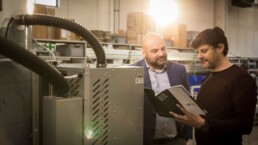Choosing the right plastic dryer (also called plastic dehumidifier) is crucial for plastics processors. In this article, we will explore the elements that influence the drying process and look at the different types of dehumidifiers. Then we will present the innovative Vismec rotor dryers.
Plastic dehumidification: the criteria
Effective plastic granule drying preserves material properties, improves aesthetics, reduces processing time and the risk of faulty production.
However, the result of dehumidification may vary according to different elements that depend on the characteristics of the plastic material, external factors and the conditions under which the drying process takes place.
When subjected to heat, thermoplastics, including plastic granules, become malleable. They are divided into hygroscopic thermoplastics, with both internal and external moisture, and non-hygroscopic thermoplastics, with moisture limited to the surface. This is an important first distinction when choosing the most suitable dryer for a plastics processing company.
However, there are other factors that affect the process result. Here are the main ones.
- Dew point: the temperature at which the air becomes saturated with moisture. Accurately measuring the dew point prevents condensation during drying.
- Set temperature: affects the performance of the dehumidifier and can also have an impact on material properties, e.g. for advanced materials such as bioplastics.
- Drying time: when it is too long, it carries the risk of thermal, physical or chemical degradation of the material. In addition, it has an impact on process organisation.
- Air flow rate: when it is adjustable according to material specifications, it allows a more accurate and efficient drying.
- Material type and shape: influence the specific drying used strategies.
- Initial and final humidity. To correctly set the drying parameters, it is important to both measure the moisture present in the material at the beginning of the process and to determine the desired final moisture content.
The choice of the ideal plastic dryer has to be determined by the balance between these factors.
Characteristics of different types of plastic dryers and Vismec solutions
We will now very briefly present the different drying methods. Then, we will focus on the features and advantages of the rotor dryers designed and manufactured by Vismec compared to other solutions.
Let’s see what systems are available to companies that process plastic materials.
- Hot air ovens: an expensive manual system, which allows small quantities of material to be dehumidified, provides a limited control over the process and ultimately does not guarantee optimal results.
- Hot air dryers: they provide continuous drying and can be installed either on board or beside the machine. However, they have high energy costs, are influenced by environmental conditions and are only suitable for non-hygroscopic materials.
- Compressed air dehumidifiers: they also allow continuous drying, can be installed beside the machine and require little space. However, they are only effective for small production runs, generate high indirect costs and process control is limited.
- Microwave plastic dryers: they expose plastics to risks related to material degradation. They are not suitable for industrial use.
- Infrared dehumidifiers: they permit continuous drying and accelerate the process. However, they are only applied to large production runs and involve high costs and consumption. In addition, their control is complicated and there is a risk of contaminating the material.
- Vacuum dryers: the continuous drying process reduces process time and does not subject the material to any harmful stress. In addition, energy consumption and maintenance time are limited. However, this system is only suitable for small production runs and has high purchase costs.
- Molecular sieve dryers: they also allow a continuous drying process, can be installed on board or beside the machine, and are not subject to limits on production quantities. However, their dew point is inconstant, and the molecular sieves degrade very quickly, so they must be often replaced.
Vismec rotor dryers have different and innovative features compared to the solutions described so far. The wheel, the pivotal element of the system, rotates thanks to a stepper motor and air passes through it in the 3 phases that we will see below.
- Dehumidification: the air is dried and then passes into the heating chamber, which enables it to reach the desired temperature. Next, the hot, dry air dries the plastic granules.
- Regeneration: The second section of the wheel is crossed by hot air generated by a chamber and a dedicated blower.
- Cooling: the wheel is cooled and then returned to the first drying section.
The advantages of the Vismec rotor dryers are many, starting with the efficiency of the process. The machine is more compact and has reduced maintenance requirements. In addition, the traditional molecular sieves are replaced by a wheel with a special honeycomb structure that is much stronger.
Other advantages include:
- drying temperature of up to 180°C without using cooling water;
- constant and adjustable dew point down to-50°C;
- energy consumption reduced by 40 % and monitoring from display;
- air flow regulation;
- preset and adjustable reference parameters with Smart mode system;
- MPM – Material Protection Management, a system to protect material from over-wetting and degradation;
- SLS – Safety Loading System, a safety system to prevent non-dehumidified material from reaching the processing machine.
The features and benefits of Vismec rotor dryers are many more than we have presented. This makes them effective and adaptable to the different companies needs. Contact our team to learn more.
